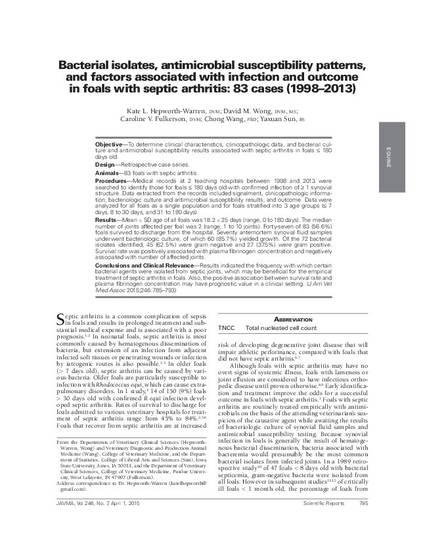
Objective—To determine clinical characteristics, clinicopathologic data, and bacterial culture and antimicrobial susceptibility results associated with septic arthritis in foals ≤ 180 days old.
Design—Retrospective case series.
Animals—83 foals with septic arthritis.
Procedures—Medical records at 2 teaching hospitals between 1998 and 2013 were searched to identify those for foals ≤ 180 days old with confirmed infection of ≥ 1 synovial structure. Data extracted from the records included signalment, clinicopathologic information, bacteriologic culture and antimicrobial susceptibility results, and outcome. Data were analyzed for all foals as a single population and for foals stratified into 3 age groups (≤ 7 days, 8 to 30 days, and 31 to 180 days).
Results—Mean ± SD age of all foals was 18.2 ± 25 days (range, 0 to 180 days). The median number of joints affected per foal was 2 (range, 1 to 10 joints). Forty-seven of 83 (56.6%) foals survived to discharge from the hospital. Seventy antemortem synovial fluid samples underwent bacteriologic culture, of which 60 (85.7%) yielded growth. Of the 72 bacterial isolates identified, 45 (62.5%) were gram negative and 27 (375%) were gram positive. Survival rate was positively associated with plasma fibrinogen concentration and negatively associated with number of affected joints.
Conclusions and Clinical Relevance—Results indicated the frequency with which certain bacterial agents were isolated from septic joints, which may be beneficial for the empirical treatment of septic arthritis in foals. Also, the positive association between survival rate and plasma fibrinogen concentration may have prognostic value in a clinical setting.
Available at: http://works.bepress.com/chong-wang/69/

This article is from Journal of the American Veterinary Medical Association 246 (2015): 785, doi: 10.2460/javma.246.7.785. Posted with permission.